
Buyer’s Guide: Choosing the Right Bedside Commode
2024-09-06 15:30
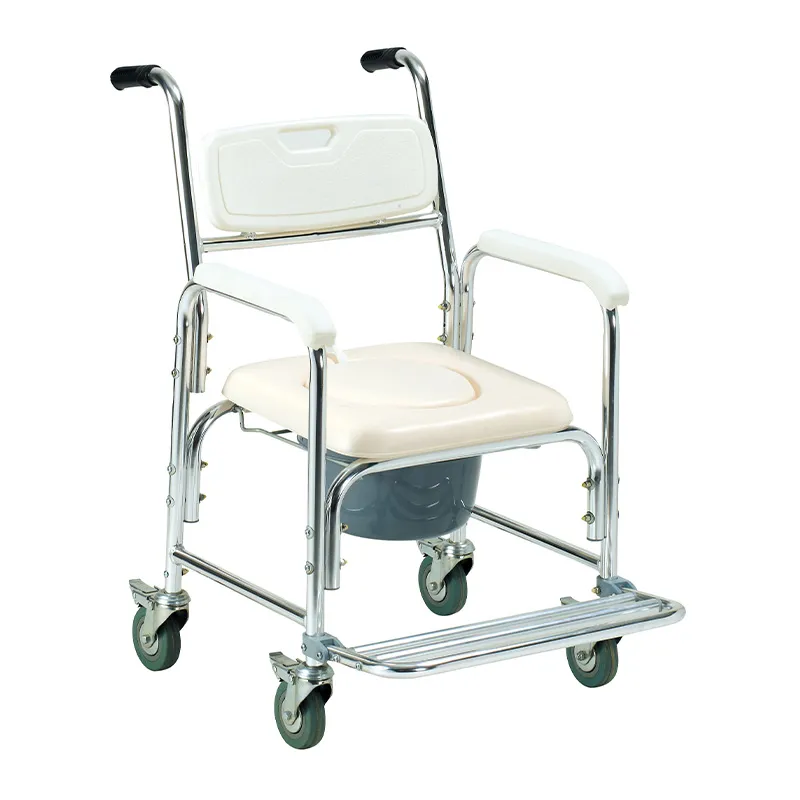
As the global population ages and the number of patients with chronic diseases and mobility issues continues to increase, bedside commodes are becoming a necessity in an increasing number of homes and care facilities. In this context, it is particularly important to know how to choose the right bedside toilet. Whether you're choosing a bedside commode for yourself or a family member, this article will provide you with a comprehensive guide to help you make an informed purchasing decision.
What Proportion Will Buy Bedside Toilets in 2023?
In 2023, as the global aging trend intensifies, the demand for bedside toilets will increase significantly. Especially in the United States, the purchase of bedside toilets accounts for a considerable share of the overall medical assistive devices market. According to statistics, the number of consumers who purchased bedside toilets in 2023 has reached 10% of the market share. This reflects that more and more families and nursing institutions attach importance to such products.
What Is A Bedside Commode?
A bedside toilet, also known as a mobile toilet or portable toilet, is a device designed to facilitate toileting for people with limited mobility. It is usually placed next to the bed and is used by people who are unable to get to the bathroom quickly or easily due to illness, injury or old age. Bedside commodes come in many forms, including commode chairs and commode wheelchairs, each with their own specific function and purpose.
● Commode Wheelchair: Commode Wheelchair is a bedside commode equipped with wheels. The design combines the functions of a wheelchair, allowing the user to move from the bed to the bathroom or other locations with the help of a caregiver. Toilet wheelchairs are usually equipped with a bedpan or removable sanitary facilities to facilitate users to use the toilet at any time.
● Commode Chair: The commode chair is a fixed bedside toilet, usually without wheels. It has a simple design and is mainly used to be placed beside the bed or in the corner of the room for users to use at night or when they have limited mobility. Toilet chairs often come with armrests and backrests for added comfort and safety.
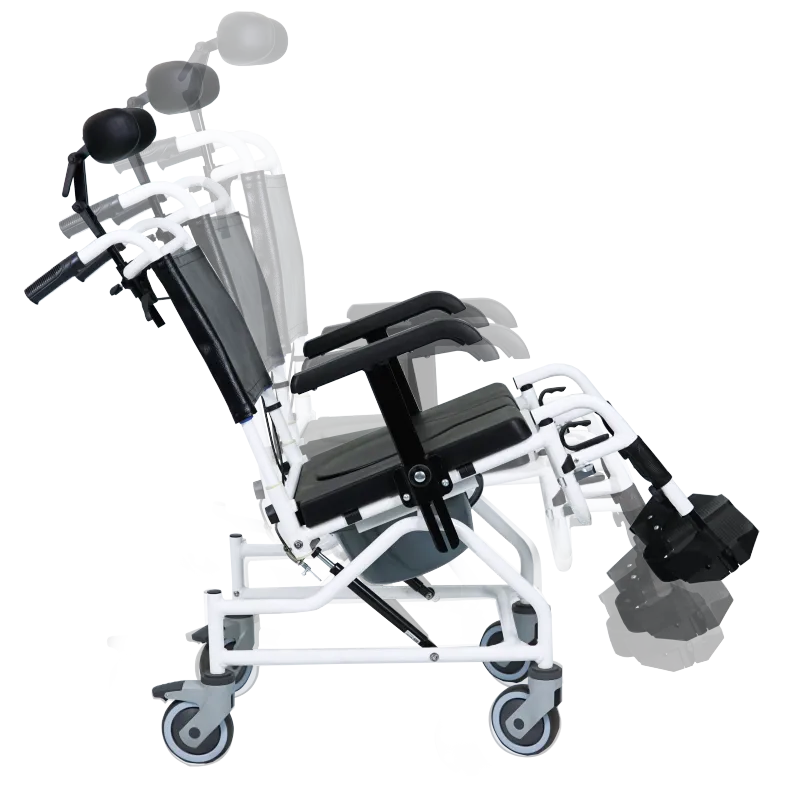
Who Should Use the Bedside Commode?
The Main Target Groups of Bedside Toilets Include the Following Categories:
● Elderly people
● Patients recovering from surgery
● People with limited mobility
● Pregnant women
● Patients with chronic diseases
● Elderly people: As they age, many Elderly people may have difficulty getting to the bathroom quickly due to joint problems, loss of muscle strength, or other health issues. A bedside commode can provide convenience and reduce the hassle of trips to the bathroom at night or in emergencies.
● Postoperative recovery patients: During recovery after surgery, many patients may need to avoid excessive activity for a short period of time. Bedside toilets provide these patients with a convenient way to go to the toilet, helping them complete their daily lives without increasing physical burden.
● People with limited mobility: Whether due to illness, injury, or disability, people with limited mobility often require additional assistive devices to complete basic living needs. A bedside commode can help them maintain their independence while reducing the frequency of dependence on others.
● Pregnant women: For women in late pregnancy, frequent nighttime toileting needs may increase inconvenience and risk. Bedside commodes can reduce the number of trips they make to the bathroom during the night, reducing the risk of accidents due to fatigue or balance issues.
● People with chronic conditions: People with chronic conditions, such as heart disease, diabetes, or respiratory disease, may need to reduce strenuous activity or avoid walking around for long periods of time. Bedside commodes can provide these patients with a safe and convenient toileting option.
What Types of Bedside Toilets Are There?
According to the design and function, bedside toilets can be divided into: standard bedside toilets, folding bedside toilets, heavy-duty bedside toilets, convertible bedside toilets, and bedside toilets with wheels.
Standard Bedside Toilets
Standard bedside toilets usually have a simple and stable design, suitable for placement beside the bed or in the corner of the room. It usually comes with a removable bedpan and adjustable height legs to suit the needs of different users.
Standard bedside toilets are suitable for those who can use the toilet by themselves but need extra support and convenience.
Folding Bedside Toilets
Folding bedside toilets are compact in design and can be folded and stowed when not in use to save space. This type of toilet is particularly suitable for small households or situations where the toilet needs to be moved frequently.
Folding bedside toilets are suitable for users who need temporary use or have limited space, especially when they need to carry a bedside toilet when traveling or visiting.
Heavy-Duty Bedside Toilets
Heavy-duty bedside toilets are designed to carry users with higher weights and usually have wider seats and higher weight-bearing capacity. Its structure is more solid, providing additional stability and safety.
The heavy-duty bedside toilet is suitable for users with heavier weight, providing a safer and more comfortable toileting experience.
Convertible Bedside Toilet
The convertible bedside toilet can be used in a multi-functional way, as a bedside toilet, placed on a standard toilet as a walking aid, and can also be used as a shower chair. Its design is flexible and suitable for a variety of occasions and uses.
The convertible bedside toilet is suitable for users who need multi-functional use, especially those who need to frequently change the use environment.
Bedside Toilet With Wheels
The bedside toilet with wheels can be easily moved around the room and is usually used for patients who need to move a short distance around the room. It is equipped with locking wheels and a removable bedpan for convenience and safety.
The bedside toilet with wheels is suitable for users who need to move around the room and use the toilet at the same time, especially when used with the help of a caregiver.
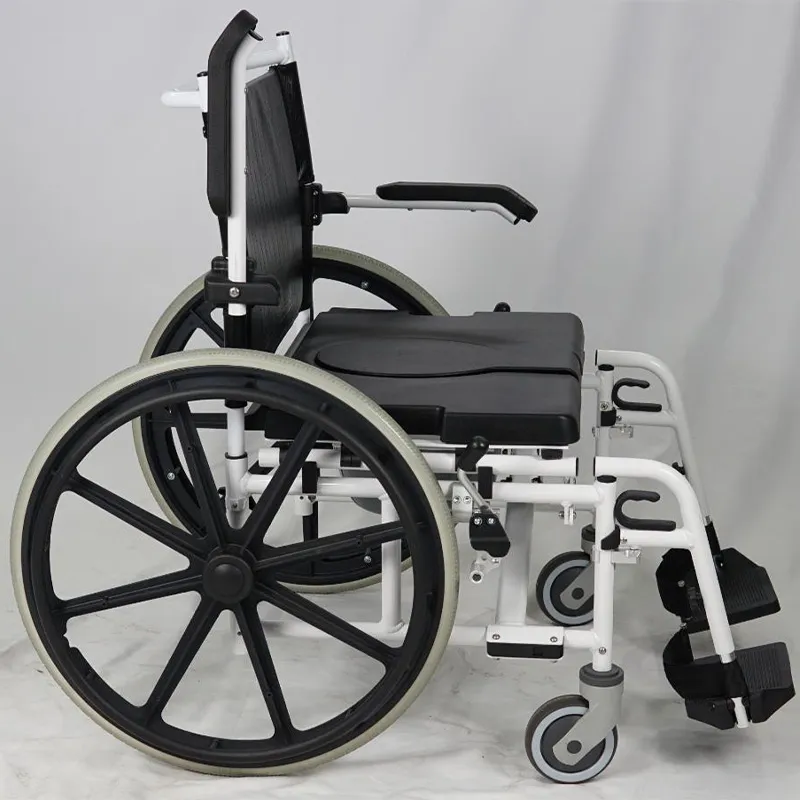
Commode Wheelchair Vs. Commode Chair: Which One Is Best?
When choosing a bedside commode, many people may be hesitant between a commode wheelchair and a commode chair. Although both devices help people with mobility issues use the toilet, their functions and applicable scenarios are different.
Commode Wheelchair
● Pros: The biggest Pros of the toilet wheelchair is its mobility. Users can transfer from bed to the bathroom or other rooms with the help of a caregiver, and commode wheelchairs are often equipped with a bedpan and footrest to provide full support. It can also be used as a regular wheelchair when not in use, adding versatility.
● Cons: Commode wheelchairs are generally larger and heavier than commode chairs, making them less suitable for rooms with limited space. Additionally, they are also usually more expensive and require a larger budget.
Commode Chair
● Pros: The toilet chair is simple in design, usually lightweight, and suitable for placement next to the bed or in the corner of the room. It’s generally more affordable, making it an affordable option. The toilet chair can also be used as a shower chair or placed on a standard toilet, adding flexibility of use.
● Cons: The toilet chair lacks mobility and may not be convenient enough for users who need to move around the room. Additionally, toilet chairs may not be designed to be stable enough for those who need extra support and stability.
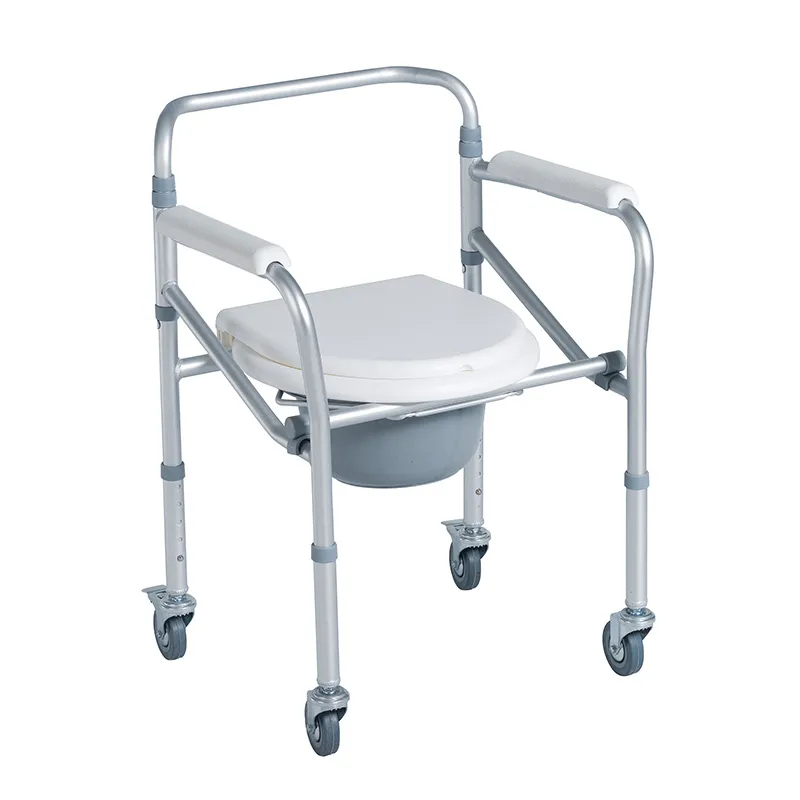
What Are the Accessories for Bedside Toilets?
Bedside commodes often come with a variety of accessories that can be adjusted or added to the user's needs to enhance the experience.
Removable bedpan
Most bedside commodes come with a removable bowl for easy cleaning and replacement. These potties are usually made of plastic, are lightweight and durable, and some models come with splash-proof lids and carry handles for added convenience.
Armrest
Armrests can provide users with extra support to help them maintain balance while sitting or standing. Armrests are an important assistive device for users with weak muscle strength or poor balance abilities.
Backrest
Some bedside commodes feature backrests to provide the user with additional comfort and support. The backrest can help users maintain good posture and reduce fatigue during use.
Foot pedal
Toilet wheelchairs are usually equipped with footrests to provide users with leg support and increase comfort. Footrests can usually be folded or height-adjusted to suit different usage needs.
Anti-slip mat
Anti-slip mats can be placed on the legs of the bedside toilet to increase stability and prevent the toilet from sliding during use. This is especially important for users who require extra stability and security.
Wheel
A bedside commode on wheels can make it easier for users to move around the room, especially when used with the help of a caregiver. The wheels usually come with a locking device to ensure they don't move accidentally while in use.
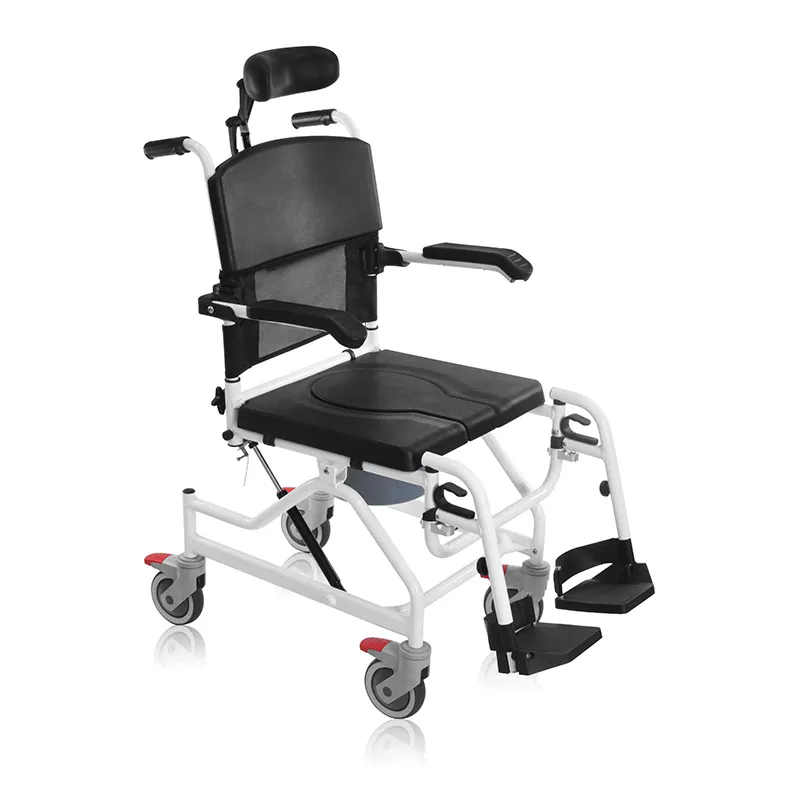
For Your Own Use: How to Use a Bedside Toilet?
For those who are able to use their own bedside commode, here are some steps and tips:
1. Adjust the height of the toilet: Before use, make sure the height of the bedside toilet has been adjusted to a height that suits you. Your feet should be flat on the ground, with your knees bent at a 90-degree angle.
2. Stable placement: Place the bedside toilet next to the bed or other convenient place to ensure it is stable and will not slide. If possible, use non-slip pads for added stability.
3. Sit down slowly: Stand in front of the toilet next to the bed, hold the armrests or the edge of the toilet with both hands, and sit down slowly. Ensure body balance and avoid sudden movements.
4. Clean the bedpan: After use, remove the bedpan, empty and clean it. If you are using a disposable poop bag, just replace it with a new one.
5. Wash your hands and clean: After use, be sure to wash your hands and clean the bedside toilet to ensure it is hygienic and safe for next use.
Help Others Use: How to Use the Bedside Toilet?
If you need to help someone use the bedside toilet, here are some steps and suggestions:
1. Ensure safety: When helping others use the bedside toilet, first ensure that the toilet is firmly placed and there are no obstacles around it.
2. Assisted getting up: When helping users get up from the bed, first have them sit on the edge of the bed with their feet on the ground. Hold their arms or handrails and help them stand up slowly.
3. Move to the toilet: Hold the user's arms or waist and help them slowly move to the bedside toilet. Make sure their feet are firmly on the ground and then sit down slowly.
4. Supervise use: If the user requires ongoing assistance, ensure they maintain balance at all times when using the bedside commode and be ready to provide support.
5. Clean up and wash hands: After use, help users clean themselves and the bedside commode, and make sure they wash their hands before returning to bed.
How to Keep Your Bedside Toilet Clean?
Cleaning and maintaining your bedside toilet is critical to its long-term use. The bedpan should be cleaned immediately after daily use to prevent odor and bacterial growth. Cleaning can be done with warm water and antibacterial detergent to ensure the dirt is completely removed. Additionally, using a splash cover inside the bedpan can reduce the amount of cleaning required and keep the bedside commode clean.
If you use disposable poop bags, be sure to change them regularly to avoid spills caused by overfilling or breakage of the poop bags. Wipe down armrests, backrests and seat areas regularly, use antibacterial wipes or disinfectant, and keep bedside commodes sanitary.
If you are using a bedside toilet with wheels, check the condition of the wheels and footrest regularly to make sure they are not damaged or worn and that the locking mechanism is working properly.
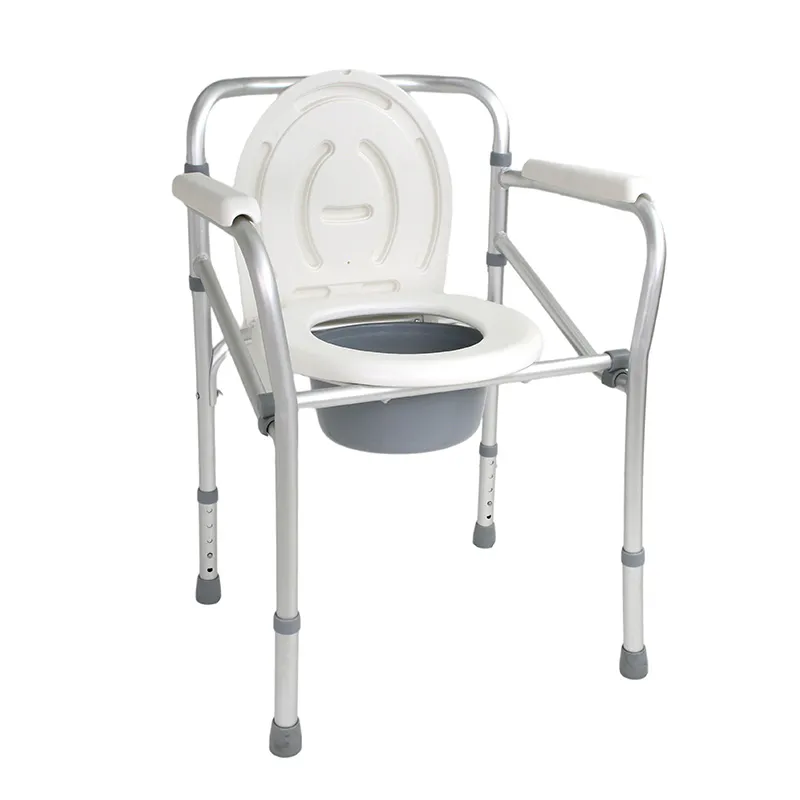
Are Bedside Commodes Covered by Medicare?
Medicare typically does not fully cover the cost of a bedside commode, but in some cases, a bedside commode may be considered durable medical equipment (DME) and thus qualify for partial reimbursement. To determine if you are eligible, it is recommended that you check with your medical provider and insurance company. Some private insurance plans may also cover the cost of a bedside commode, especially if prescribed by a doctor.
What Is the Weight Capacity of a Bedside Toilet?
The weight capacity of bedside commodes varies by model and design. The weight capacity of a standard bedside toilet is usually around 300 pounds (about 136 kg), while the weight capacity of a heavy-duty bedside toilet can be as high as 500 pounds (about 227 kg) or more. When choosing, be sure to choose a suitable bedside toilet based on the user's weight to ensure safety and comfort.
Summary of Bedside Toilets
Choosing the right bedside toilet can not only improve the user's quality of life, but also reduce the burden on caregivers. When choosing, you need to consider the individual needs of the user, the space in the room, and the functionality and design of the bedside toilet. Hopefully this guide will help you find the perfect bedside toilet to make every bathroom trip safer and more convenient.








